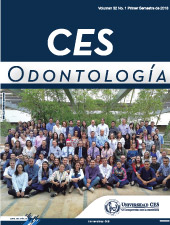Characterization of hybrid layer intraradicular dentin pretreated with sodium hypochlorite 5.25% using two cementing agents with auto adhesives and conventional engraving
DOI:
https://doi.org/10.21615/cesodon.31.1.2Keywords:
cementing agents, oral rehabilitation, hybridized dentin, pretreated layerAbstract
Introduction and objective: At present, the rehabilitation of endodontically treatedteeth is a huge demand for professional in oral rehabilitation. For this reason, theneed to identify and manage the core processes and biological determinants thatinfluence a good process of dentinal adhesion. The aim of this study was to characterizethe hybrid layer in dentin intraradicular pretreated with sodium hypochlorite(NaClO) 5.25 % using two cementing agents with self adhesive systems and conventionaletching. Materials and Methods: 40 single-rooted premolar teeth which wererandomized into 4 groups were selected. Group A: dentin pretreated with 5.25% NaClO5.25% and RelyX® Ultimate cemented with cement (3M). Group B: (control group A,without pretreated dentin). Group C: dentin pretreated with NaClO 5.25% and cementedwith cement ParaCore® and group D: Control group, not pretreated of dentin.The teeth were transected and the presence of hybrid layer was analyzed in cervicalthirds and root medium by scanning electron microscopy. Results:Statisticallysignificant differences in the thickness of the hybrid layer of teeth pretreated withNaClO 5.25% met and bonded with paraCore® compared to cementated with RelyX®Ultimate value p = 0.023 Anova test.Downloads
References
Amaral M, Rippe MP, Konzen M, Valandro LF. Adhesion between fiber post and root dentin: evaluation of post surface conditioning for bond strength improvement. Minerva stomatologica. 2011;60(6):279-287.
Alsamadani KH, Abdaziz el SM, Gad el S. Influence of different restorative techniques on the strength of endodontically treated weakened roots. International journal of dentistry. 2012;2012:ID:343712.
Breschi L, Mazzoni A, Ruggeri A, Cadenaro M, Di Lenarda R, De Stefano Dorigo E. Dental adhesion review: aging and stability of the bonded interface. Dental materials: official publication of the Academy of Dental Materials. 2008;24(1):90-101.
Hashimoto M, Ohno H, Endo K, Kaga M, Sano H, Oguchi H. The effect of hybrid layer thickness on bond strength: demineralized dentin zone of the hybrid layer. Dental materials : official publication of the Academy of Dental Materials.
;16(6):406-411.
de Oliveira FG, Anchieta RB, Rahal V, de Alexandre RS, Machado LS, Sundefeld ML, et al. Correlation of the hybrid layer thickness and resin tags length with the bond strength of a self-etching adhesive system. Acta odontologica latinoamericana: AOL. 2009;22(3):177-181.
Albaladejo A, Osorio R, Toledano M, Ferrari M. Hybrid layers of etch-and-rinse versus self-etching adhesive systems. Medicina oral, patologia oral y cirugia bucal. 2010;15(1):112-128.
Andrabi SM, Kumar A, Kumar Tewari R, Kumar Mishra S, Iftekhar H. An In Vitro SEM Study on the Effectiveness of Smear Layer Removal of Four Different Irrigations. Iranian endodontic journal. 2012;7(4):171-176.
Mosharraf R, Baghaei Yazdi N. Comparative evaluation of effects of different surface treatment methods on bond strength between fiber post and composite core. The journal of advanced prosthodontics. 2012;4(2):103-108.
Herrera E. Fracasos en la adhesión. Av Odontoestomatol. 2005;21(2):63-69.
Abou-Id LR, Morgan LF, Silva GA, Poletto LT, Lanza LD, Albuquerque Rde C. Ultrastructural evaluation of the hybrid layer after cementation of fiber posts using adhesive systems with different curing modes. Brazilian dental journal. 2012;23(2):116-121.
Kahnamouei MA, Mohammadi N, Navimipour EJ, Shakerifar M. Push-out bond strength of quartz fibre posts to root canal dentin using total-etch and self-adhesive resin cements. Medicina oral, patologia oral y cirugia bucal. 2012;17(2):337-344.
Valenzuela A ZP. Hibrid layer micromorphology of two adhesive systems. TEM analysis. Av Odontoestomatol. 2012;28(3):133-140.
Uribe-Echevarrí J, Lutri P, Sezín M, Priotto EG, Carda-Batalla C; Spadiliero de Lutri MM. Adhesión a dentina a través de distintos tratamientos del sustrato. RAOA 2004;92(4): 315-321.
D’Arcangelo C, Zazzeroni S, D’Amario M, Vadini M, De Angelis F, Trubiani O, et al. Bond strengths of three types of fibre-reinforced post systems in various regions of root canals. International endodontic journal. 2008;41(4):322-328.
Sánchez GR, Ramírez NC, Medina RF. Adhesión convencional en dentina, dificultades y avances en la técnica 1/conventional dentin bonding. difficulties and progress in the technique 1. Rev Fac Odontol Univ Antioq 2015;26(2):468-486.
Downloads
Published
How to Cite
Issue
Section
License
Copyright (c) 2021 CES Odontología

This work is licensed under a Creative Commons Attribution-NonCommercial-ShareAlike 4.0 International License.
| Article metrics | |
|---|---|
| Abstract views | |
| Galley vies | |
| PDF Views | |
| HTML views | |
| Other views | |



